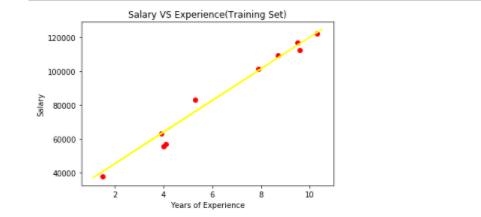
Download our e-book of Introduction To Python
Related Blog
Matplotlib - Subplot2grid() FunctionDiscuss Microsoft Cognitive ToolkitMatplotlib - Working with ImagesMatplotlib - PyLab moduleMatplotlib - Working With TextMatplotlib - Setting Ticks and Tick LabelsCNTK - Creating First Neural NetworkMatplotlib - MultiplotsMatplotlib - Quiver PlotPython - Chunks and Chinks View More
Top Discussion
How can I write Python code to change a date string from "mm/dd/yy hh: mm" format to "YYYY-MM-DD HH: mm" format? Which sorting technique is used by sort() and sorted() functions of python? How to use Enum in python? Can you please help me with this error? I was just selecting some random columns from the diabetes dataset of sklearn. Decision tree is a classification algo...How can it be applied to load diabetes dataset which has DV continuous Objects in Python are mutable or immutable? How can unclassified data in a dataset be effectively managed when utilizing a decision tree-based classification model in Python? How to leave/exit/deactivate a Python virtualenvironment Join Discussion
Top Courses
Webinars
Project 4: Prediction of salary Based on years of experience

Shashank Shanu
2 years ago

Table of Contents
- Problem Statement
- Dataset description
- Model Building
- Visualization
- Model Evaluation
- Conclusion
Problem Statement
To build a machine learning model and predict the salary of the employees based on year of experience
Dataset description
- This dataset is randomly created to show you how we can use machine learning technique and build a Linear Regression model to predict the salary of an employee based on years of experience.
- This dataset consists of two columns
- Salary- Represent the salary of a person.
- Years- Years of experience
- Note: - It's a small dataset which is being used for only demo purpose.
Importing libraries
import pandas as pd
import numpy as npImporting data
data = pd.read_csv("Salary_Dataa.csv")Displaying dataset
dataOutput:

Checking shape of dataset
data.shapeOutput:
(30, 2)- We can see that our dataset consists of 30 observations and 2 rows only. These are very small dataset as it is created randomly to show how we can build a regression model.
Checking dataset information
data.info()Output:
RangeIndex: 30 entries, 0 to 29
Data columns (total 2 columns):
# Column Non-Null Count Dtype
--- ------ -------------- -----
0 YearsExperience 30 non-none float64
1 Salary 30 non-none float64
dtypes: float64(2)
memory usage: 608.0 bytes- We can see that both the variables are of float data types
Checking for none values
data.isnone().count()Output:
YearsExperience 30
Salary 30
dtype: int64- We can see that there are no missing values are present in our dataset
Model Building
Splitting of dataset into independent and dependent variables
X = data.iloc[:,:-1].values
Y = data.iloc[:,1].valuesIndependent variable
XOutput:
array([[ 1.1],
[ 1.3],
[ 1.5],
[ 2. ],
[ 2.2],
[ 2.9],
[ 3. ],
[ 3.2],
[ 3.2],
[ 3.7],
[ 3.9],
[ 4. ],
[ 4. ],
[ 4.1],
[ 4.5],
[ 4.9],
[ 5.1],
[ 5.3],
[ 5.9],
[ 6. ],
[ 6.8],
[ 7.1],
[ 7.9],
[ 8.2],
[ 8.7],
[ 9. ],
[ 9.5],
[ 9.6],
[10.3],
[10.5]])
Dependent variable
YOutput:
array([ 39343., 46205., 37731., 43525., 39891., 56642., 60150.,
54445., 64445., 57189., 63218., 55794., 56957., 57081.,
61111., 67938., 66029., 83088., 81363., 93940., 91738.,
98273., 101302., 113812., 109431., 105582., 116969., 112635.,
122391., 121872.])Plotting Scatter plot to check relationship between independent variable and dependent variable
import matplotlib.pyplot as plt
plt.scatter(X,Y,color = "blue")Output:

- We can observe that the independent and dependent variable is linearly related to each other
Splitting dataset for training set and testing set
from sklearn.model_selection import train_test_split
x_train,x_test,y_train,y_test = train_test_split(X,Y,test_size=0.33,random_state = 0)
Displaying x_train
x_trainOutput:
array([[ 2.9],
[ 5.1],
[ 3.2],
[ 4.5],
[ 8.2],
[ 6.8],
[ 1.3],
[10.5],
[ 3. ],
[ 2.2],
[ 5.9],
[ 6. ],
[ 3.7],
[ 3.2],
[ 9. ],
[ 2. ],
[ 1.1],
[ 7.1],
[ 4.9],
[ 4. ]])Displaying y_train
y_trainOutput:
array([ 56642., 66029., 64445., 61111., 113812., 91738., 46205.,
121872., 60150., 39891., 81363., 93940., 57189., 54445.,
105582., 43525., 39343., 98273., 67938., 56957.])Displaying y_test
y_testOutput:
array([ 37731., 122391., 57081., 63218., 116969., 109431., 112635.,
55794., 83088., 101302.])Fitting Simple Linear regression to the training set
from sklearn.linear_model import LinearRegression
regressor = LinearRegression()
regressor.fit(x_train,y_train)
Output:
LinearRegression(copy_X=true, fit_intercept=true, n_jobs=none, normalize=false)Predicting the Test set results
y_pred = regressor.predict(x_test)Displaying y_pred (Predicted salary)
y_pred Output:
array([ 40835.10590871, 123079.39940819, 65134.55626083, 63265.36777221,
115602.64545369, 108125.8914992 , 116537.23969801, 64199.96201652,
76349.68719258, 100649.1375447 ])Displaying y_test (Real salary)
y_test Output:
array([ 37731., 122391., 57081., 63218., 116969., 109431., 112635.,
55794., 83088., 101302.])Calculating Error/ Residue
residue = y_pred - y_test # residue or error between actual and predicted salary
residueOutput:
array([ 3104.10590871, 688.39940819, 8053.55626083, 47.36777221,
-1366.35454631, -1305.1085008 , 3902.23969801, 8405.96201652,
-6738.31280742, -652.8624553 ])Visualization
Visualizing the training set results
plt.scatter(x_train,y_train,color="red")
plt.plot(x_train,regressor.predict(x_train),color="yellow")
plt.title("Salary VS Experience(Training Set)")
plt.xlabel("Years of Experience")
plt.ylabel("Salary")
plt.show()Output:

Visualizing the testing set results
plt.scatter(x_test,y_test,color="Red")
plt.plot(x_train,regressor.predict(x_train),color="yellow")
plt.title("Salary VS Experience(Training Set)")
plt.xlabel("Years of Experience")
plt.ylabel("Salary")
plt.show()Output:

Calculating Intercept and Coefficient
print(regressor.coef_)
print(regressor.intercept_)Output:
[9345.94244312]
26816.192244031176y_test.shapeOutput:
(10,)y_pred.shapeOutput:
(10,)Model Evaluation
from sklearn.metrics import r2_score
from sklearn.metrics import mean_squared_error
rmse = np.sqrt(mean_squared_error(y_test,y_pred))
r2 = r2_score(y_test,y_pred) #built-in function r2_score() indicates R-squared value
print("RMSE =", rmse)
print("R2 Score=",r2)Output:
RMSE = 4585.415720467589
R2 Score= 0.9749154407708353Conclusion
- In this small project, We saw how we can build a machine learning model ie., Regression model and predict the salary of the employees based on years of experience.
- Here, We build a regression model and check the model RMSE which is equal to 4585.415720467589.
- We also checked for R2 score of our model which is equal to 0.9749154407708353 or 97%. Which is a very good R2 score.
I hope you enjoyed this project and also you came to know about how we can use and implement Linear Regression Algorithm.
For more such blogs/courses on data science, machine learning, artificial intelligence and emerging new technologies do visit us at https://insideaiml.com/home.
Thanks for reading…
Happy Learning…
